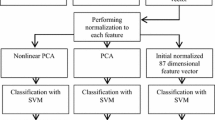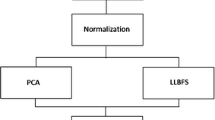Abstract
In this study, we wanted to discriminate between 30 patients who suffer from Parkinson’s disease (PD) and 20 patients with other neurological diseases (ND). All participants were asked to pronounce sustained vowel /a/ hold as long as possible at comfortable level. The analyses were done on these voice samples. Firstly, an initial feature vector extracted from time, frequency and cepstral domains. Then we used principal component analysis (PCA) and nonlinear PCA (NPCA). These techniques reduce the number of parameters and select the most effective ones to be used for classification. Support vector machine and k-nearest neighbor with different kernels was used for classification. We obtained accuracy up to 88% for discrimination between PD patients ND patients using KNN with k equal to three and five.





Similar content being viewed by others
References
Abramson, E. L., et al. (2012). Physician experiences transitioning between an older versus newer electronic health record for electronic prescribing. International Journal of Medical Informatics, 81(8), 539–548.
Andersen, T., et al. (2011). Designing for collaborative interpretation in telemonitoring: Re-introducing patients as diagnostic agents. International Journal of Medical Informatics, 80(8), e112–e126.
Atal, B. S., & Hanauer, S. L. (1971). Speech analysis and synthesis by linear prediction of the speech wave. The Journal of the Acoustical Society of America, 50(2B), 637–655.
Baker, K. K., et al. (1998). Thyroarytenoid muscle activity associated with hypophonia in Parkinson disease and aging. Neurology, 51(6), 1592–1598.
Benba, A., et al. (2015a). Voiceprints analysis using MFCC and SVM for detecting patients with Parkinson’s disease. In Electrical and information technologies (ICEIT), 2015 international conference on IEEE, Marrakech, Morocco.
Benba, A., Jilbab, A., & Hammouch, A. (2014a). Hybridization of best acoustic cues for detecting persons with Parkinson’s disease, In The 2nd world conference on complex system, Agadir, Morocco.
Benba, A., Jilbab, A., & Hammouch, A. (2014b). Voiceprint analysis using perceptual linear prediction and support vector machines for detecting persons with Parkinson’s disease.” In The 3rd international conference on health science and biomedical systems, Florence, Italy.
Benba, A., Jilbab, A., & Hammouch, A. (2014c). Voice analysis for detecting persons with Parkinson’s disease using PLP and VQ. Journal of Theoretical and Applied Information Technology, 70(3).
Benba, A., Jilbab, A., & Hammouch, A. (2014d). Voice analysis for detecting persons with Parkinson’s disease using MFCC and VQ. In The 2014 international conference on circuits, systems and signal processing, Saint Petersburg, Russia.
Benba, A., Jilbab, A., & Hammouch, A. (2015b). Detecting patients with Parkinson’s disease using PLP and VQ. In The 7th international conference on information technology, 12–15 Mai, Amman, Jordan.
Benba, A., Jilbab, A., & Hammouch, A. (2016). Discriminating between patients with Parkinson’s and neurological diseases using cepstral analysis. IEEE Trans Neural Syst Rehabil Eng. doi:10.1109/TNSRE.2016.2533582.
Boersma, P., & Weenink, D. (2001). Praat, a system for doing phonetics by computer. Glot International, 5, 341–345.
Chen H. -L., et al (2013). An efficient diagnosis system for detection of Parkinson’s disease using fuzzy k-nearest neighbor approach. Expert Systems with Applications, 40(1), 263–271.
Das, R. (2010). A comparison of multiple classification methods for diagnosis of Parkinson disease. Expert Systems with Applications, 37(2), 1568–1572.
De Lau, L. M., & Breteler, M. (2006). Epidemiology of Parkinson’s disease. The Lancet Neurology, 5(6), 525–535.
Farrús, M., Hernando, J., & Ejarque, P. (2007). Jitter and shimmer measurements for speaker recognition. Belgium: INTERSPEECH.
Gentil, M. (1990). Acoustic characteristics of speech in Friedreich’s disease. Folia Phoniatrica et Logopaedica, 42(3), 125–134.
Hermansky, H. (1990). Perceptual linear predictive (PLP) analysis of speech. The Journal of the Acoustical Society of America, 87(4), 1738–1752.
Hermansky, H., et al. (1992). RASTA-PLP speech analysis technique. San Francisco: ICASSP, IEEE.
Jankovic, J. (2008). Parkinson’s disease: Clinical features and diagnosis. Journal of Neurology, Neurosurgery & Psychiatry, 79(4), 368–376.
Jellinger, K. A. (2015). Pathogenesis of multiple system atrophy-recent developments. International Journal of Neurology and Neurotherapy, 2, 022.
Kumar, CS., & Mallikarjuna, P. R. (2011) Design of an automatic speaker recognition system using MFCC, vector quantization and LBG algorithm. International Journal on Computer Science and Engineering, 3(8), 2011.
Langston, J. W. (2002). Parkinson’s disease: Current and future challenges. Neurotoxicology, 23(4), 443–450.
Little, M. A., et al. (2009). Suitability of dysphonia measurements for telemonitoring of Parkinson’s disease. IEEE Transactions on Biomedical Engineering, 56(4), 1015–1022.
Logemann, J. A., et al. (1978). Frequency and cooccurrence of vocal tract dysfunctions in the speech of a large sample of Parkinson patients. Journal of Speech and Hearing Disorders, 43(1), 47–57.
Manciocco, A., et al. (2009). The application of Russell and Burch 3R principle in rodent models of neurodegenerative disease: the case of Parkinson’s disease. Neuroscience & Biobehavioral Reviews, 33(1), 18–32.
Mandal, I., & Sairam, N. (2013). Accurate telemonitoring of Parkinson’s disease diagnosis using robust inference system. International Journal of Medical Informatics, 82(5), 359–377.
Martinez, J., Perez, H., Escamilla, E., & Suzuki, M. M. (2012). Speaker recognition using mel frequency cepstral coefficients (MFCC) and vactor quantization (VQ) techniques. In IEEE electrical communications and computers, Cholula, Puebla, pp. 248–251.
O’Sullivan, S. B., & Schmitz, T. J. (2007). Parkinson disease. In Physical rehabilitation. Philadelphia: FA Davis Company, pp. 856–894.
Perez, K. S., et al. (1996). The Parkinson larynx: Tremor and videostroboscopic findings. Journal of Voice, 10(4), 354–361.
Qiu, F., et al. (2015). Comparative study of diagnostic significance of urethral sphincter electromyography and external anal sphincter electromyography in patients with multiple system atrophy. Journal of Neurology & Neurophysiology, 6(285), 2.
Sakar, B. E., et al. (2013). Collection and analysis of a Parkinson speech dataset with multiple types of sound recordings. IEEE Journal of Biomedical and Health Informatics, 17(4), 828–834.
Scholz, M., & Fraunholz, M., & Selbig, J. (2008). Nonlinear principal component analysis: Neural network models and applications. In: Principal manifolds for data visualization and dimension reduction. Berlin: Springer, pp. 44–67.
Stelzig, Y., et al. (1999). Laryngeal manifestations in patients with Parkinson disease. Laryngo-Rhino-Otologie, 78(10), 544–551.
Teston, B. (2001). L’évaluation objective des dysfonctionnements de la voix et de la parole; 2e partie: les dysphonies. Travaux Interdisciplinaires du Laboratoire Parole et Langage d’Aix-en-Provence, 20, 169–232.
Van Den, E., & Stephen, K., et al. (2003). Incidence of Parkinson’s disease: Variation by age, gender, and race/ethnicity. American Journal of Epidemiology, 157(11), 1015–1022.
Viallet, F., & Teston, B. (2007). La dysarthrie dans la maladie de Parkinson. Les dysarthries, 169–174.
Yang, Z. R., et al. (2005). RONN: The bio-basis function neural network technique applied to the detection of natively disordered regions in proteins. Bioinformatics, 21(16), 3369–3376.
Young, S., Evermann, G., Hain, T., Kershaw, D., Liu, X., Moore, G., Odell, J., Ollason, D., Povey, D., Valtchev, V., & Woodland, P. (2006). The HTK book (for HTK version 3.4). Cambridge: Cambridge University Engineering Department.
Author information
Authors and Affiliations
Corresponding author
Ethics declarations
Conflict of interest
Achraf Benba declares that he has no conflict of interest and he doesn’t have any financial relationship with the organization. Abdelilah Jilbab declares that he has no conflict of interest and he doesn’t have any financial relationship with the organization. Ahmed Hammouch declares that he has no conflict of interest and he doesn’t have any financial relationship with the organization.
Ethical approval
All procedures followed were in accordance with the ethical standards of the responsible committee on human experimentation (institutional and national) and with the Helsinki Declaration of 1975, as revised in 2008 (5).
Rights and permissions
About this article
Cite this article
Benba, A., Jilbab, A. & Hammouch, A. Voice assessments for detecting patients with neurological diseases using PCA and NPCA. Int J Speech Technol 20, 673–683 (2017). https://doi.org/10.1007/s10772-017-9438-9
Received:
Accepted:
Published:
Issue Date:
DOI: https://doi.org/10.1007/s10772-017-9438-9




